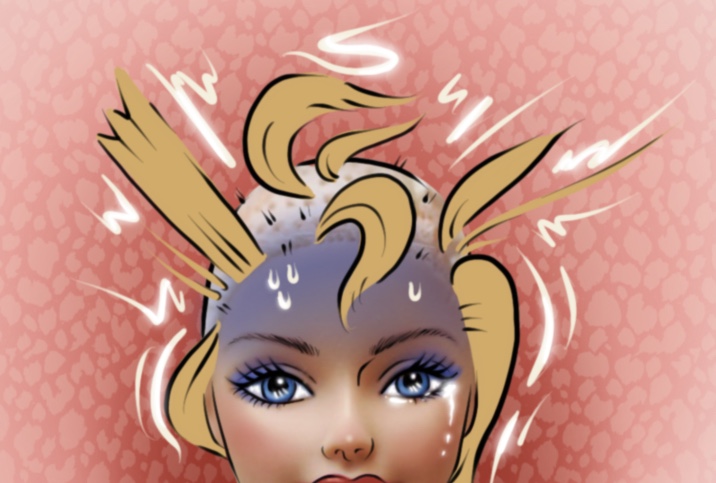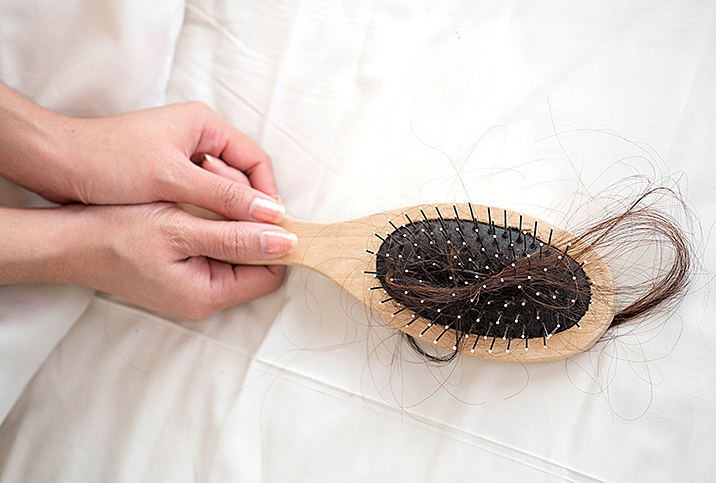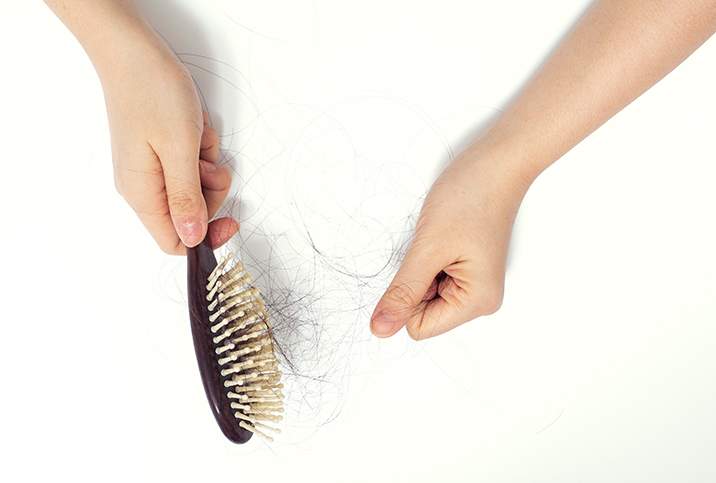Help! I'm Postpartum and My Hair Is Falling Out!

As much as you rejoice in the birth of a child, the loss of your crowning glory can strike a hard blow to the psyche. Postpartum hair loss can be emotionally and physically distressing for new moms already going through a host of other post-pregnancy issues.
Childbirth contributes to a great deal of physical and emotional stress for a woman. But while you may (attempt to) prepare yourself for conditions such as postpartum depression or weight gain, one relatively overlooked condition can cause considerable anguish: hair loss after childbirth.
Telogen effluvium (TE), or postpartum alopecia, is a type of temporary hair loss that occurs following extreme stress, emotional shock or a case of physical or emotional trauma. The top of the scalp is where it usually occurs, and the amount of hair falling out ranges from a few strands to larger clumps. However, this is almost always temporary, and your hair usually grows back.
Hair loss occurs in 40 percent to 50 percent of all women during pregnancy. Telogen effluvium is quite common and usually develops two to four months after childbirth. According to OB-GYN Kecia Gaither, M.D., from the Bronx, New York, different women experience postpartum hair loss in varying degrees.
"Thinning hair or hair loss can be gradual over months or dramatic," Gaither noted.
The condition is mostly caused by the shift in the amount of progesterone and estrogen in the body at the end of pregnancy.
Understanding postpartum hair loss
An increase in hair loss is the primary sign of telogen effluvium. When you brush or wash your hair, you may find more hair coming out than normal. Additionally, you may discover hair on your pillow or in the drain.
Keep in mind that unlike people suffering from the autoimmune condition alopecia areata, those with TE don't lose all their hair. However, the thinning may become quite obvious. Telogen effluvium occurs when the imbalance in hormones triggers a disturbance in the hair growth cycle.
Other factors affecting hair growth in the postpartum phase include physical and emotional stress, lack of restful sleep and poor nutrition, according to an article published in the journal American Family Physician. Hormonal imbalances triggered by postpartum thyroid conditions may also affect hair growth.
The telogen effluvium timeline
Telogen effluvium is a kind of alopecia that causes hair to thin or fall out more rapidly than usual. This hair shedding disproportionately affects women and happens when the hair cycle is disrupted, according to a 2019 review.
Typically, three stages make up the hair cycle:
- The growing phase, or anagen
- The transitional phase, or catagen
- The dormant phase, or telogen
Celestine Gitau, R.N., a certified trichologist and hair transplant technician in Kenya, said TE slows down the anagen phase, resulting in fewer hairs going through to the next stages. Around a third of affected hair follicles then proceed to the telogen phase, ending in hair loss.
After giving birth, your estrogen drops to prepregnancy levels. This causes the follicles in your scalp to enter the telogenic (resting) phase of growth, resulting in the growth of fewer hairs. After 100 days in the telogenic phase, the hair is shed.
Telogen effluvium after birth tends to occur between four and six months postpartum. However, if the state of your scalp doesn't improve by the sixth month after birth, it would be best to consult your gynecologist and a dermatologist to see what can be done.
Treating TE
While telogen effluvium can definitely be stressful, it is temporary, and the hair should return to its pre-effluvium density. However, according to Los Angeles OB-GYN Michael Tahery, M.D., the reversal can be slow, taking up to six months for hair loss to stop. This is followed by months to years of the hair growing back at the slow rate of a half-inch per month.
Treatment options for typical cases of TE include the following:
- Addressing any nutritional deficiencies that may aggravate hair loss, including a lack of protein as well as iron deficiency anemia.
- Professional counseling support to address postpartum depression, stress and anxiety.
- Avoiding any chemical-based or heat-centric treatments that could further damage your hair, including styling with heated blowers and irons, as well as curling or perming your hair within six months after giving birth.
In extreme cases, nonsurgical hair replacement may be recommended, along with hormone-balancing therapies to alleviate the situation.
Caring for your postpartum hair
Experts from the American Academy of Dermatology recommend the following personal measures for postpartum hair care:
- Use a volumizing shampoo and conditioner that contains proteins to make the hair look lusher and fuller.
- Avoid so-called conditioning shampoos as their formulation errs on the heavy side and weighs hair down and makes it look limp and lifeless.
- Try a new hairstyle to hide any temporary hair loss. Rely on the expertise of your stylist as they can advise you on what styles look best and are low maintenance during your busy postpartum period.
Many women have a deeply emotional attachment to hair, so postpartum hair loss can be distressing. However, this condition is self-correcting, and you should recover your hair volume in time.
If you still see clumps in your hairbrush six months after giving birth, you may want to consult an expert to ensure your hair loss isn't due to an underlying condition.


















